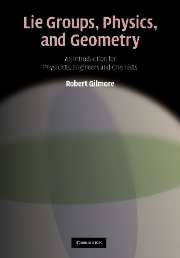Book contents
- Frontmatter
- Contents
- Preface
- 1 Introduction
- 2 Lie groups
- 3 Matrix groups
- 4 Lie algebras
- 5 Matrix algebras
- 6 Operator algebras
- 7 EXPonentiation
- 8 Structure theory for Lie algebras
- 9 Structure theory for simple Lie algebras
- 10 Root spaces and Dynkin diagrams
- 11 Real forms
- 12 Riemannian symmetric spaces
- 13 Contraction
- 14 Hydrogenic atoms
- 15 Maxwell's equations
- 16 Lie groups and differential equations
- Bibliography
- Index
14 - Hydrogenic atoms
Published online by Cambridge University Press: 05 September 2012
- Frontmatter
- Contents
- Preface
- 1 Introduction
- 2 Lie groups
- 3 Matrix groups
- 4 Lie algebras
- 5 Matrix algebras
- 6 Operator algebras
- 7 EXPonentiation
- 8 Structure theory for Lie algebras
- 9 Structure theory for simple Lie algebras
- 10 Root spaces and Dynkin diagrams
- 11 Real forms
- 12 Riemannian symmetric spaces
- 13 Contraction
- 14 Hydrogenic atoms
- 15 Maxwell's equations
- 16 Lie groups and differential equations
- Bibliography
- Index
Summary
Many physical systems exhibit symmetry. When a symmetry exists it is possible to use group theory to simplify both the treatment and the understanding of the problem. Central two-body forces, such as the gravitational and Coulomb interactions, give rise to systems exhibiting spherical symmetry (two particles) or broken spherical symmetry (planetary systems). In this chapter we see how spherical symmetry has been used to probe the details of the hydrogen atom. We find a hierarchy of symmetries and symmetry groups. At the most obvious level is the geometric symmetry group, SO(3), which describes invariance under rotations. At a less obvious level is the dynamical symmetry group, SO(4), which accounts for the degeneracy of the levels in the hydrogen atom with the same principal quantum number. At an even higher level are the spectrum generating groups, SO(4, 1) and SO(4, 2), which do not maintain energy degeneracy at all, but rather map any bound (scattering) state of the hydrogen atom into linear combinations of all bound (scattering) states. We begin with a description of the fundamental principles underlying the application of group theory to the study of physical systems. These are the principle of relativity (Galileo) and the principle of equivalence (Einstein).
Introduction
Applications of group theory in physics start with two very important principles. These are Galileo's principle of relativity (of observers) and Einstein's principle of equivalence (of states).
- Type
- Chapter
- Information
- Lie Groups, Physics, and GeometryAn Introduction for Physicists, Engineers and Chemists, pp. 221 - 258Publisher: Cambridge University PressPrint publication year: 2008



